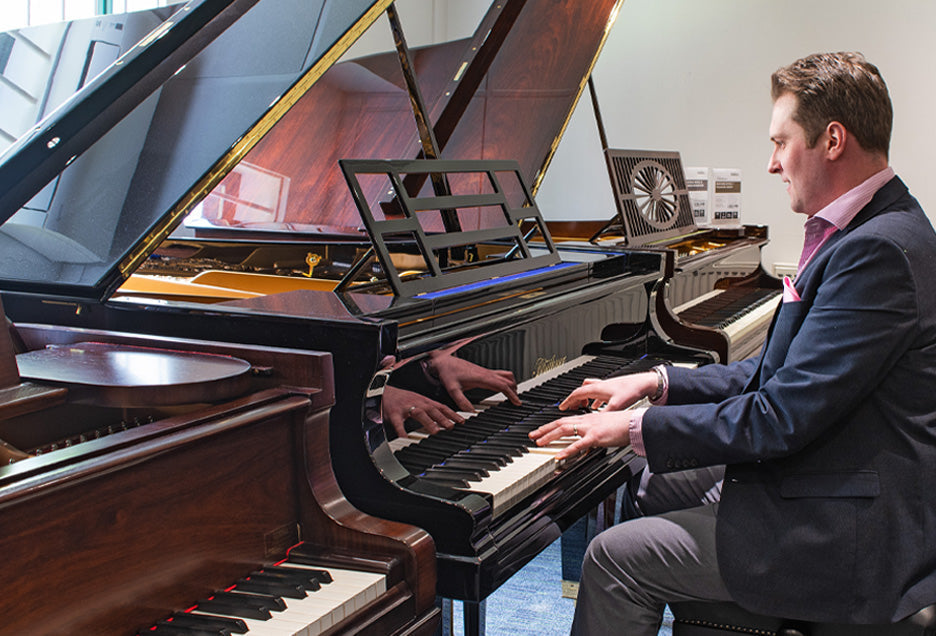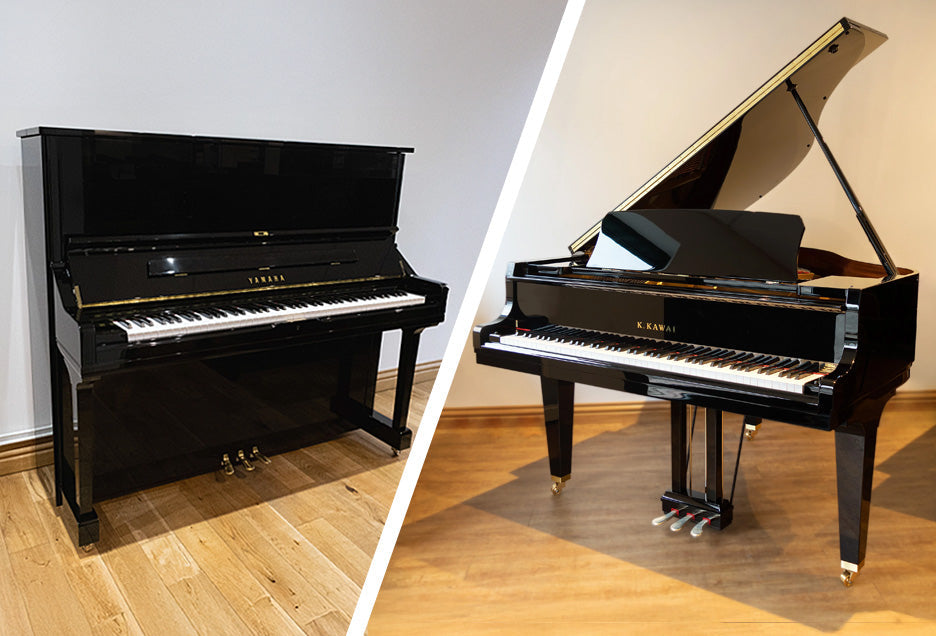Of course the ultimate piano purchase is always a real acoustic instrument, with hammers, strings and a wooden soundboard to amplify the sound. An acoustic piano, whether an upright or a grand, allows for fantastic depth of musical expression with a natural resonance from its wooden components and strings vibrating together. Acoustic piano ownership, however, isn’t always practical, with digital or electronic pianos providing an ideal compromise. But what is a digital piano?
In its simplest form, a digital piano has been designed to mimic the sound and the feel of an acoustic piano as closely as possible. Rather than having hammers which strike strings to produce the sound, sensors within a specially constructed keyboard mechanism, known as the action, trigger samples or recordings of an acoustic piano which are then amplified through speakers. There are no strings to tune and no real maintenance required either.
The action of a digital piano has keys which are the same shape as those found on an acoustic piano, and are mostly the same length with 88 notes (or 7 ¼ octaves). These keys have hammer mechanisms attached to them; this is not actually used to strike the strings, but to provide the same feeling of resistance and dynamic response as an acoustic instrument. On acoustic pianos, due to the thickness and length of the strings, the hammers are larger and heavier in the bass and smaller and lighter in the treble. Therefore, the weight of the hammers in digital pianos is scaled to replicate this feeling of key weighting. The price point of the digital piano tends to correlate with how faithfully the sound and feel replicate the acoustic piano playing experience, with lower priced digital pianos having plastic keys and more advanced models featuring wooden keyboards with increased sensitivity.
Manufacturers such as Yamaha and Kawai record or sample their own concert grand pianos for their main piano sounds, meaning that when you play an acoustic piano loudly, the timbre of the sound changes too. Therefore, recordings are taken of each note at multiple different dynamic levels to ensure that the sound produced by the digital piano keyboard is as natural as possible. Sophisticated modelling technologies and algorithms are applied to capture the resonance of an acoustic piano, getting more and more advanced the higher up the range you go.
Ultimately, the more money you spend, the closer to an acoustic piano these instruments become.
Acoustic or digital?
There are a number of factors to consider when deciding between an acoustic and a digital piano.
Budget & maintenance
One should consider how much they can realistically afford to spend on purchasing and maintaining a piano. New acoustic upright pianos start at around £3,000 for the entry-level Yamaha and Kawai models, rising to nearly £10,000 for larger uprights or baby grands. There are of course second hand options, and we always have a great supply of excellent quality pre-owned options by makers such as Yamaha, Kawai, Kemble and more to purchase from as little as £1,500.
Intermediate, mid-sized uprights are available at around the £5,000 price point, and these instruments would be suitable for taking a musician through to the higher grades and beyond. On the other hand, digital pianos start from as little as £700 for a cabinet style model with built in pedals, with wooden key models from £2,000 and upwards.
An acoustic piano needs to be tuned twice a year, and the current UK average price is roughly £80, or £160 per year. Acoustic pianos towards the lower end of the price scale are also usually compact models, and once a pianist reaches a more advanced level of playing it is recommended that one upgrades to a larger and more expressive instrument. Generally speaking, if your budget is under £2,000 you can usually get a higher specification digital piano than you can an acoustic, but no digital piano will ever quite replicate the wonderful natural resonance of an acoustic instrument.
Space
Available space is an increasingly important factor to be taken into account when deciding on the right instrument for you. Digital pianos are usually much more compact than acoustic pianos, are lighter in weight and you also don’t have to be quite as careful about where you put it. Acoustic instruments should be kept in an environment where the temperature and humidity is as stable as possible in order to maintain its tuning stability, while digital pianos, with no wooden soundboard or tuning plank, can be placed anywhere. If you have the space for an acoustic piano and it is away from direct heat sources in a stable environment then there is simply nothing better!
Features & convenience
Digital pianos have the benefit of many additional features, as well as being a replica of an acoustic piano. For instance, the volume can be controlled, and you can plug in headphones to enable silent practice at unsociable times. Digital pianos are also equipped with MIDI, either via USB or Bluetooth, facilitating connectivity with apps and DAWs and making them a useful tuition or music production tool. Useful features such as metronomes and record facilities are built in, while some models also have rhythm backings to aid composing and making practising more fun.
Acoustic pianos are available with hybrid systems, such as Yamaha’s Silent and TransAcoustic series, which offer the same convenient features as digital pianos including the ability to plug in headphones and connect to smart devices. These really do combine the best of both worlds and increasingly popular with families, institutions and piano teachers. Although an ideal middle-ground, hybrid systems significantly increase the price, and if one would rarely be able to play acoustically, or the piano is left unused for extended periods of the year, then it might be better to purchase a good digital piano instead. An excellent compromise in this situation would be a Yamaha AvantGrand or Kawai Novus, which feature a real acoustic piano actions in a digital instrument.
Longevity
The elephant in the room when it comes to digital pianos is longevity and resale value. The technology in an acoustic piano has been largely unchanged for the last 120 years, with most major developments centred around refinement and convenience. A traditional instrument made primarily from wood and metal parts will last for many decades when well maintained, and can be passed down through generations. Consequently ten, fifteen, twenty and even thirty year old acoustic pianos by respected manufacturers can retain their value very well indeed and are sought after on the second hand market, and we regularly purchase and sell such acoustic instruments.
Digital piano technology on the other hand, similarly to mobile phones, computers and televisions, is constantly evolving with new models being released every few years, and this means that what is a top spec model today will become obsolete very quickly. Manufacturers of electronic items are obligated by law to support them for a certain period of time, but once 20 or 30 years old a digital piano would not be worth repairing if it developed a fault. The cost of new acoustic pianos is rising year on year, and while one never makes money out of owning a piano, it is certainly a better long-term investment than a digital instrument.
Summary
In summary, nothing will ever quite beat owning a real acoustic piano, and the experience can only be enhanced by the addition of a hybrid system to give you all the benefits that a digital piano can bring. However, digital pianos can be less of a financial risk for parents buying for young beginners, and with technology constantly improving, the gulf between the playability of an acoustic and digital piano is rapidly shrinking.
When choosing to go acoustic or digital, one should really consider their own circumstances: Is it convenient to have a loud, large instrument in the home? Are you making a long-term or comparatively short term investment? Which features would be of most benefit for your particular requirements?
Our piano experts are always delighted to help find the most suitable instrument for your needs, so start a conversation with us today at pianos@chamberlainmusic.com or 01428 647593.



